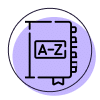
Token classification refers to the process of assigning a label or category to each token or element in a text stream. Tokens can be individual words, numbers, symbols and other elements in a text. Token classification is commonly used in natural language processing and machine learning for tasks such as sentiment analysis, information extraction and document classification.
Token classification involves labelling each token with a specific category based on its meaning or function in the text. For example, in a sentence, verbs can be labelled as "VERB", nouns as "NOUN", adjectives as "ADJECTIVE", and so on.
To perform token classification, machine learning algorithms, such as neural network-based classification models, are used, which can learn to assign categories to tokens based on text features and labels already existing in a training dataset.
Token classification is a fundamental technique in natural language processing and is essential for many applications, such as text generation, machine translation, natural language understanding and sentiment analysis in social networks.
Natural Language Processing or NLP analyzes how machines understand, interpret and process human language.
Read More »Industry 4.0 is the name given to the fourth industrial revolution, which is characterized by the inclusion of advanced technologies in production processes.
Read More »The rise of Artificial Intelligence (AI) in business is very topical. Its use is spreading and is changing, even, the models [...]
Read More »AI is the science that will make the difference between two companies competing in the same industry. Machine learning and machine intelligence will [...]
Read More »